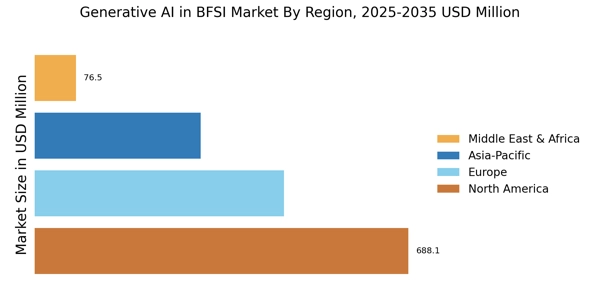The Generative AI in BFSI Market is currently characterized by a dynamic competitive landscape, driven by rapid technological advancements and an increasing demand for automation and efficiency in financial services. Key players such as OpenAI (US), Google (US), and Microsoft (US) are at the forefront, leveraging their extensive research capabilities and technological prowess to innovate solutions tailored for banking, insurance, and financial services. OpenAI (US) focuses on enhancing customer engagement through advanced chatbots and virtual assistants, while Google (US) emphasizes data analytics and machine learning to optimize risk assessment and fraud detection. Microsoft (US) is strategically positioning itself by integrating generative AI into its cloud services, thereby facilitating seamless digital transformation for BFSI clients. Collectively, these strategies not only enhance operational efficiencies but also intensify competition within the market.
In terms of business tactics, companies are increasingly localizing their offerings to cater to regional market needs, which appears to be a response to the diverse regulatory environments across different geographies. The market structure is moderately fragmented, with a mix of established players and emerging startups. This fragmentation allows for a variety of innovative solutions, although the collective influence of major players like IBM (US) and NVIDIA (US) remains substantial, as they continue to set benchmarks in AI capabilities and infrastructure.
In September 2025, IBM (US) announced a strategic partnership with a leading European bank to develop a generative AI-driven platform aimed at enhancing customer service and operational efficiency. This collaboration is significant as it not only showcases IBM's commitment to integrating AI into traditional banking processes but also highlights the growing trend of financial institutions seeking to leverage advanced technologies to improve customer experiences. Such partnerships are likely to become more prevalent as banks strive to remain competitive in a rapidly evolving landscape.
In August 2025, Microsoft (US) launched a new suite of AI tools specifically designed for the insurance sector, focusing on claims processing and risk assessment. This initiative underscores Microsoft's strategy to penetrate niche markets within BFSI, thereby enhancing its value proposition. By streamlining operations through AI, Microsoft positions itself as a leader in providing tailored solutions that address specific industry challenges, which could potentially reshape how insurance companies operate.
In July 2025, Google (US) unveiled a generative AI model aimed at improving compliance and regulatory reporting for financial institutions. This move is particularly noteworthy as it addresses a critical pain point for banks and financial services, which often struggle with the complexities of regulatory requirements. By offering solutions that simplify compliance, Google not only strengthens its foothold in the BFSI sector but also aligns with the broader trend of digitalization and regulatory technology integration.
As of October 2025, the competitive trends within the Generative AI in BFSI Market are increasingly defined by digitalization, sustainability, and the integration of AI into core business processes. Strategic alliances are becoming a cornerstone of competitive advantage, as companies recognize the need to collaborate to enhance their technological capabilities. Looking ahead, it is likely that competitive differentiation will evolve from traditional price-based strategies to a focus on innovation, technological advancement, and the reliability of supply chains. This shift may redefine how companies approach market entry and customer engagement, emphasizing the importance of agility and responsiveness in a fast-paced environment.


















Leave a Comment